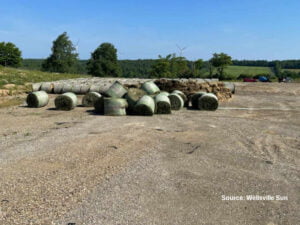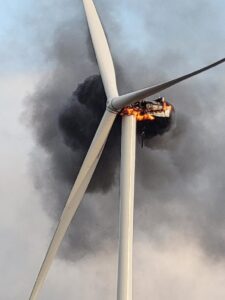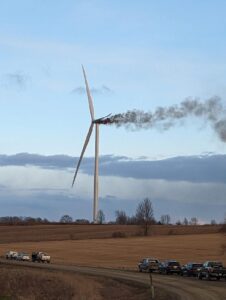
And Mullen Farms’ problems are far from over. NextEra claimed they would clean up the field and remove the fiberglass. This was started but never completed. The company that NextEra contracted with to perform the cleanup has left and stated they are finished. This while Mullen’s hay fields are still covered in fiberglass. Because of this, it is unusable. Not only did they already lose their first crop, but they will lose their second crop too. And most likely their third. They’ve attempted to contact NextEra multiple times to complete the cleanup, but NextEra has ignored them. When a local newspaper asked NextEra if they would have the cleanup completed in time for the 2024 season, NextEra refused to answer. Meanwhile, Mullen Farms is left with their livelihood completely destroyed.

Though it seems there is some controversy as to whether fiberglass by itself is carcinogenic, it’s also worth pointing out that burning something fundamentally changes its chemical composition such that a substance that might not be particularly toxic on its own can become toxic after it is burned. One need look no further than their own kitchen for examples of this. By itself, bread is harmless. But burned toast is not because the burning process oxidizes starches in the bread and converts them into acrylamide, a chemical that is known to be carcinogenic and also cause nerve damage. The same thing happens when frying starchy foods like potatoes in vegetable oil.
One thing that is not in dispute is that ingesting fiberglass particles can cause severe stomach irritation. Mullen Farms has consulted with veterinarians who believe that ingesting fiberglass strands could be fatal to cows or horses.
But even if there really is no danger from consuming burned strands of glass and plastic, the fact is, I wouldn’t want to eat food contaminated with fiberglass, I doubt you would want to eat it, and I doubt anyone at NextEra would be willing to eat it either if I told them there was fiberglass mixed in with it. I wouldn’t feed it to my animals, and the FDA would certainly issue a recall on food if it were found to be contaminated with fiberglass. Real health risks or not, Mullen’s can’t feed their hay to their own animals, nor can they sell it to other farmers or horse owners. The simple fact is that no one is going to buy hay that is contaminated with fiberglass.
Make no mistake. Burning wind turbines are similar to small-scale nuclear accidents in that they can contaminate agricultural fields more than a mile away from the turbine, rendering the soil unusable for long periods of time. The difference? In the 70 plus year history of nuclear power, there have only been two accidents in the entire world that have caused significant off-site contamination, where as there are dozens of wind turbine fires every single year. And some, like this one, devastate the livelihood of farmers.

Sources:

Subsidized electricity brought to you by demoCraps.
Only thing uglier would be solar panels on producing agricultural lands.
Both have made Oregon ugly and needs to be stopped.
Build more dams.
Clean and safe.